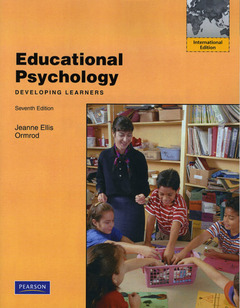Description
Educational psychology 7/e, ormrod (7th ed )
Author: ORMROD Jeanne E.
Language: English
Approximative price 85.00 €
In Print (Delivery period: 12 days).
Add to cart768 p. · 21.6x27.9 cm · Paperback
Description
/li>Contents
/li>
The best-selling Educational Psychology: Developing Learners is known for its exceptionally clear and engaging writing, its in-depth focus on learning, and its extensive concrete applications. Its unique approach helps readers understand concepts by encouraging them to examine their own learning and then showing them how to apply these concepts as teachers. The book concentrates on core concepts and principles and gives readers an in-depth understanding of the central ideas of educational psychologyhelping them better understand the children and adolescents.
More than any other educational psychology book, this book moves seamlessly between theory and applications, features the most extensive and integrated coverage of diversity, and includes innumerable concrete examples to help readers connect educational psychology to real children and classrooms.
Chapter1
Teaching and Educational Psycholog 1
CASE STUDY: Picture Yourself 1
Teaching as Evidence-Based Practice 2
Understanding Research 4
Quantitative Research 5 Ï Qualitative Research 7 Ï
Interpreting Research Results: A Cautionary Note 8 Ï
From Research to Practice: The Importance of Theories 9
Collecting Data and Drawing Conclusions About Your Own
Students 10
Assessing Students' Achievements and Behaviors 10 Ï
Conducting Action Research 11
Developing as a Teacher 12
Strategies for Studying and Learning Effectively 13
The Big Picture 14
PRACTICE FOR YOUR LICENSURE EXAM 15
PART I
Development and Diversity
Chapter 2
Cognitive and Linguistic Development 19
CASE STUDY:Apple Tarts 19
General Principles of Human Development 20
The Multiple Layers of Environmental Influence:
Bronfenbrenner's Theory 22
Role of the Brain in Learning and Development 23
Piaget's Theory of Cognitive Development 26
Piaget's Basic Assumptions 27 Ï Piaget's Stages of
Cognitive Development 29 Ï Critiquing Piaget's Theory
34 Ï Considering Diversity from the Perspective of
Piaget's Theory 35 Ï Contemporary Extensions and
Applications of Piaget's Theory 36
Vygotsky's Theory of Cognitive
Development 38
Vygotsky's Basic Assumptions 39 Ï Critiquing
Vygotsky's Theory 43 Ï Considering Diversity from the
Perspective of Vygotsky's Theory 43 Ï Contemporary
Extensions and Applications of Vygotsky's Theory 44
Language Development 49
Theoretical Issues Regarding Language Development 49 Ï
Trends in Language Development 50 Ï Diversity in
Language Development 53 Ï Second-Language Learning
and English Language Learners 53
The Big Picture 57
PRACTICE FOR YOUR LICENSURE EXAM 58
Chapter 3
Personal and Social Development 61
CASE STUDY: Hidden Treasure 61
Personality Development 62
Temperament 62 Ï Environmental Influences on
Personality Development 63 Ï The 'Big Five' Personality
Traits 66 Ï Temperament, Personality, and Goodness of
Fit 66
Development of a Sense of Self 66
Factors Influencing Sense of Self 68 Ï Developmental
Changes in Sense of Self 71 Ï Diversity in Sense of Self
74
Development of Peer Relationships and Interpersonal
Understandings 75
Roles of Peers in Children's Development 76 Ï
Characteristics of Peer Relationships 77 Ï Social Cognition
81 Ï Aggression 84 Ï Technology and Peer
Relationships 86 Ï Diversity in Peer Relationships and
Social Cognition 87 Ï Promoting Health Peer
Relationships 87
Moral and Prosocial Development 90
Developmental Trends in Morality and Prosocial Behavior 90
Ï Factors Influencing Moral and Prosocial Behavior 95 Ï
Diversity in Moral and Prosocial Behavior 95 Ï
Encouraging Moral and Prosocial Development in the
Classroom 97
The Big Picture 99
ALBQ149_Frontmatter.qxp 9/1/09 3:32 PM Page v
vi Contents
PRACTICE FOR YOUR LICENSURE EXAM 100
Chapter 4
Group Differences 103
CASE STUDY:Why Jack Wasn't in School 103
Cultural and Ethnic Differences 104
Navigating Different Cultures at Home and at School 105
Ï Examples of Cultural and Ethnic Diversity 107 Ï
Creating a Culturally Inclusive Classroom Environment
113
Gender Differences 118
Research Findings Regarding Gender Differences 118 Ï
These books may interest you

Human Learning 94.54 €



